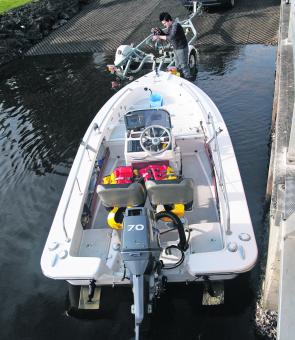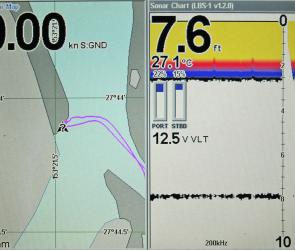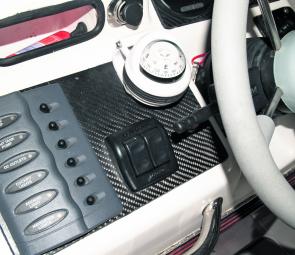Anyone who says a properly set up deep-vee hull – glass or alloy – doesn’t need trim tabs obviously hasn’t used them.
Like most people who have, I honestly wonder how I did without them for so long. Used in half-second bursts, trim tabs give total control of the boat orientation in almost all sea and wind conditions.
Most types of powerboat trim tabs comprise two adjustable planing surfaces extending from the transom, working in a manner roughly similar to the ailerons on an aircraft. Lowering the rear surface creates drag and lift, forcing the bow down and the stern up.
Add independent port and starboard controls and you can adjust the orientation of the vessel with impressive precision, lifting or dropping one side of the boat with ease.
Tabs are for when water, wind and/or boat loading are less than optimal – they can limit bow squat on hole shots and can adjust the boat so it stays level and rides softer in a sea, regardless of wind and sea direction or vessel load distribution.
Why not just rely on engine trim? Your engine hits a ‘sweet spot’ of peak thrust efficiency when the axis of the prop and the bottom of the hull are trimmed roughly parallel. Trim in or out from that point and peak efficiency is lost.
If you don’t have a fuel flow read-out, you can get a fair idea of the sweet spot in the engine trim by using no tabs and running the engine up to a fair running speed and applying progressively more out trim until the torque load comes off the steering wheel. It’s easier to turn the wheel because the hull is up and running in almost exactly the axis the prop is pushing.
Check your engine trim gauge and note that trim level; it’s what you should be aiming for to gain peak efficiency.
Trim out too far, though, and you’ll ventilate the prop or, worse still, aerate the water intake.
When used together, trim tabs and power trim provide optimum performance for the hull while allowing the motor to achieve peak efficiency.
Regardless of make, a pair of rocker switches somewhere near the helm activates the tabs. Many brands have separate LEDs on the switches to show how much port/starboard tab is applied and some tabs also allow for auto retraction once the engine’s ignition is turned off, so the tabs always start reset to zero.
Because of the 22.5° transom deadrise of my Haines TD149, I’d always planned to fit trim tabs. In previous boats I’d experienced the deep-vee tendency to lay on the upwind chine in a crosswind.
In a relatively short boat with such a deep deadrise, I also aimed to level and boost hole-shot lift and to adjust lateral trim in a crosswind or with uneven crew distribution.
By mounting my trim tabs well away from the hull’s centreline, I also may have added a little more ‘static’ stability – stability at rest.
My research led me to the US-made Bennett tabs because of their ease of owner fitment and impressive customer service worldwide. National distributors Harrold Marine in Brisbane (www.harroldmarine.com.au) suggested the M80 tab kit, Lowrance NMEA 2000 interface ‘insects’ and all the advice and expertise I required.
Out of everything I installed on my project boat, the Bennett tabs were the most hassle-free to fit. A quick look at the DVD, a scan of the paper instructions and I was away.
Every fastener and fuse came with the kit and the 12V hydraulic pump bled itself once I filled the reservoir with normal automatic transmission fluid – a breeze!
The NMEA interface means the bar graph overlay on my 7” Lowrance screen shows the exact percentage of each tab, no matter what screen page I have open.
I’ve never had to use over 35% tab to correct any trim situation and at normal cruising speeds or faster in calm water, I simply retract them until they’re needed.
If you have to use more than 50% trim on one or both tabs, I’d say there’s a trim or engine/hull rigging deficiency somewhere on your craft. You should look to correct it by redistributing the hull load or adjusting the engine mounting height.
As soon as their surfaces are in contact with the water, tabs will create some extra friction so don’t expect to add to your top speed. You can, however, expect some fuel savings in rough water if your engine is performing more efficiently.
When travelling into a lumpy head sea, I keep the bow down with the tabs while holding my engine trim at the optimum, letting the sharp parts of the hull iron out the ride.
In a windy beam sea, where a deep-vee hull can tend to drop the upwind gunwale, I can add enough bow-down tab on the opposite side to counteract this and provide a level ride. Or I can add even more trim to keep those hull surfaces at a sharper approach angle to the incoming swell and chop.
In a following sea, I retract the tabs altogether and often trim the engine out a fraction further, as long as I’m not getting prop aeration. That’s to keep the bow from even the remotest tendency to bury hard, which can slow down efficient progress, burn up more fuel and even cause dangerous broaching.
If the boat surfs smoothly down the swell, tracks straight in the trough as the bow digs a little and then bobs back up as the engine drives up the back of the next swell, we get maximum hull efficiency and negligible porpoising.
Porpoising in calmer water can also be cured by judicious tab application but the underlying problem, usually the engine mounted too low, still remains until that is corrected.
Conversations with other boat owners indicate they use their tabs similarly. All other owners I have spoken to are just as wary of using tabs in a following sea.
Owners of craft fitted with all brands of trim tabs seem to be happy with their general operation and reliability.
I don’t know anyone who has installed the reasonably new Minn Kota tabs yet, but this company has the runs on the board with their other products.
One thing all owners agree on is that tabs need to be adjusted in small increments – a little tweak of a switch goes a long way to adjusting a hull’s attitude. And when they know how to use them, all owners say the same thing: “Trim tabs? How did I live without ’em?”
Facts
TAB TYPES, INSTALLATION
Trim tabs come in sizes and formats to suit most craft. The planing surfaces are mainly of stainless steel or ultra-tough ABS plastic, with strong hinges fixed to the vessel’s transom. An electric grub-screw, piston or hydraulic ram activates the angle of each tab.
Volvo’s QL tabs, however, act more like a jet’s air brakes, electrically moving a smaller blade straight down and parallel with the transom to create drag, which lowers the hull on that side. They serve no planing function.
The others are available in various widths and lengths and there should be no problem in finding a pair that’s right for your boat, whatever size it is. Many manufacturers have websites that allow owners to calculate the right tabs for their vessel.
Tab manufacturers have ensured that their products can be installed in most boats, regardless of transom design or structure. If you’re thinking of installing tabs on your new boat, discuss the possibilities with your boat builder. If it’s a reputable firm, chances are they have a tried and true brand and model that works best for your hull and can install and plumb/wire the tabs at the appropriate point in hull construction. On my Haines Traveller project boat I had to install the tabs almost before I started anything else. As I was designing and building the transom area I had to ensure I left enough room to route hydraulics and to house the tab pump.
Retrofitting tabs to a hull is a viable option in most cases. Most tab companies have all the bits to enable easy fit-up, even if you can’t get to the interior part of the transom.
1
In beefy offshore deep-vee craft like this CruiseCraft 685 Explorer, trim tabs can help counteract off-centre loads and allow the hull to perform to its optimum in a wide range of sea conditions. Better fuel economy can be the result of a more efficiently trimmed hull, too.
2
The Bennett M80 tabs on the author’s Haines TD149 project boat protrude about 25cm from the transom. Having them mounted as far from the centre line as possible also allows them to provide some increased stability at rest.
3
The Bennett hydraulic trim tabs are simple to install with just a straight edge, a screwdriver, a drill and a bottle of automatic transmission fluid. All fittings and fasteners come with the kit, along with an instructional video. The port tab here is trimmed down around 20%, while the starboard one is retracted.
4
Some tabs have NMEA connectivity to enable tab deployment on electronic screens. The column graphs on this Lowrance GPS/sonar show the port tab is down 22% and the starboard one 15%.
5
The rocker switches allow independent use of port and starboard tabs. Half-second bursts are enough to detect a difference. On this installation the tab controls and engine trim stalk can be adjusted without the skipper’s hand leaving the wheel.
6
Trim tabs can be fitted to most hulls, even those with less traditional transoms. This Cootacraft has the Lenco electric actuators mounted to the engine pod, while the custom fibreglass tab planes and hinges are fixed to the transom.
Bennett – Harrold Marine 3/19 Success St, Acacia Ridge, Brisbane QLD 4110 Phone 07 3277 6563
Minn Kota – BLA
Lenco – Sam Allen Wholesale
Lectrotab – EJ Milde & Co 5/47 OG Road Klemzig SA 5087 P: (08) 8261 5411 --e-mail address hidden--
Volvo QL – Volvo Penta distributors










